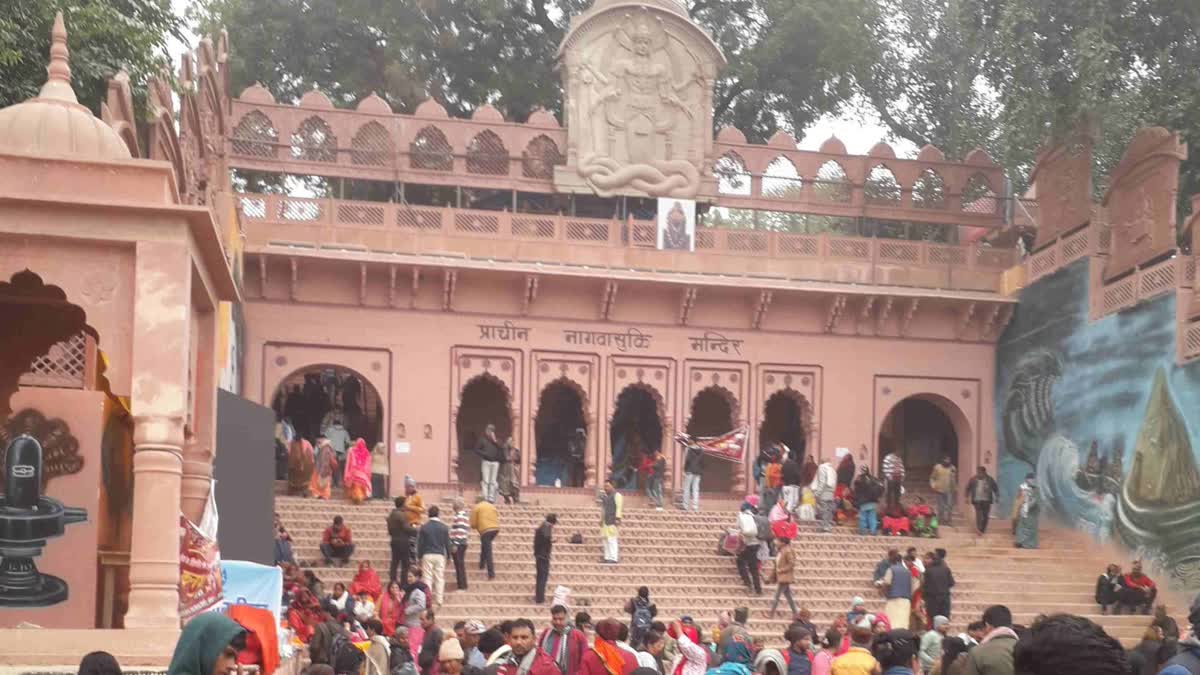Prayagraj: The numbers looked almost the same. People! In crores! On Wednesday, even as crores of people headed to the Triveni Sangam during the ongoing Mahakumbh Mela to take the Amrit Snan, the holiest of dips in the Ganga on the occasion of Makar Sankranti, an almost equal number of people were seen heading towards another direction after taking the bath leaving one wondering what the destination was.
It turned out to be the Nagvasuki Mandir, situated some kilometres north of the Triveni Sangam and to the extreme north of the Daragani locality of Prayagraj. Situated on the banks of the Ganga, it is the only temple in India that is dedicated to Nag Vasuki, the king of serpents in Hindu mythology. Despite the physically challenging trek to the Triveni Sangam, many were seen taking up another challenging journey to the Nag Vasuki Mandir. They went on to climb up the steep steps to pay obeisance to the king of serpents.
Many of the devotees believe that not visiting the Nagvasuki Mandir after taking the holy dip in the Ganga leaves the pilgrimage to the Mahakumbh Mela incomplete. According to Hindu texts, Nag Vasuki is a vital figure in Indian mythology. He is mentioned in the Samudra Manthan (churning of the ocean), a major episode in Hinduism that is elaborated in the Vishnu Purana.
He is accorded a significant role in the legend of Samudra Manthana. He is described to have allowed both the devas and the asuras to bind him to Mount Mandara, so that they could use him as their churning rope to extract the amrita (elixir of life) from the Ocean of Milk.
In Hinduism, serpents (nagas) symbolise both fear and protection, representing dual aspects of life. They are considered guardians of treasures, knowledge, and secrets of the universe.
Vasuki is closely associated with Lord Shiva, who wears him around his neck. This connection signifies the control of primal energy and the balance of life forces.
Pilgrims visit the Nagvasuki Mandir to seek protection from fears, particularly the fear of unknown dangers. The temple’s serene location near the Ganga also offers an opportunity for meditation and reflection.
The most important festival at the Nagvasuki Mandir is Nag Panchami, celebrated in the month of Shravana (July-August). Devotees gather in large numbers to offer prayers, milk, and flowers to Nag Vasuki, seeking protection from snake bites and blessings for prosperity.
BP Dubey, retired professor of the Department of Ancient History, Culture and Archaeology in Allahabad University, gives a historical perspective to the Nagvasuki Mandir.
“This temple dates back to 450 years,” Dubey told ETV Bharat. “Earlier, it was a small shrine. The present structure dates back to 150 years.”
He stated that a family with the surname Tandon had migrated to Allahabad (as Prayagraj was then known) from Agra. It was this family that had the temple constructed in its present form. The family was renowned for its philanthropic activities.
“The Tandon family was the treasurer of the British East India Company,” Dubey said. “The family also held the keys to the British treasury in the Allahabad Fort. Due to the family’s strong social influence given their philanthropic activities, the British could not move their treasury from Allahabad Fort even when they tried to.”
Coming back to the significance of the Nagvasuki Mandir, Dubey said that Prayagraj had three serpent shrines.
“The one on the north is the Nagvasuki Mandir,” he said. “Another one was on the west in Atar Suya area and was known as Kambal Ashvatar. The third one was on the south and was called Bahumulak. On the east was a well named after Emperor Samudra Gupta.”
Dubey explained that the area bounded by the three serpent shrines and the well was known as Prajapati Kshetra. The area outside this was known as Prayag and the area bigger than this was known as Prayag Mandal.
Asked about some devotees’ belief that they should visit the Nagvasuki Mandir while coming for Kumbha Melas in Prayagraj lest it left the pilgrimage incomplete, Dubey replied: “I don’t know much about this. But people who come to Prayagraj for a short time try to visit the Nagvasuki Mandir as well.



